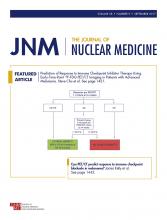TO THE EDITOR: Deandreis et al. (1) compared the overall survival (OS) of 2 patient groups with metastatic differentiated thyroid cancer (mDTC). One group of patients underwent multiple 131I treatments using a standard administered activity (AA) of 3.7 GBq (100 mCi) at Gustave Roussy (GR), whereas the other group received individualized maximal tolerated activity (MTA) therapy at the Memorial Sloan Kettering Cancer Center (MSKCC). Finding no differences in OS between the approaches of GR and MSKCC, the authors generalized their findings to conclude that therapy using MTAs is no better than multiple standard AAs. We concur with previously expressed concerns regarding the study design (2,3) and would like to offer additional comments.
The MTA formalism at MSKCC is not adequately described in the provided references. The individual calculated MTAs at MSKCC were not reported (1), but the AAs were lower than in our experience (4). This raises concern that AAs differ from calculated MTAs. The authors should report MTAs along with AAs, explaining any differences between the two.
In the 1950s, Benua and Leeper (5) observed that “metastases treated with either small repeated doses of 131I or with external irradiation seemed to lose the ability to function [that is, accumulate iodine] but continued to grow.” That was their reason for developing the MTA-based approach at MSKCC that permitted administration of much higher AAs. They also observed that thyroid hormone withdrawal was the most effective stimulation for iodine uptake in mDTC, which their successors substituted by recombinant human thyroid-stimulating hormone (rhTSH) without proof of equivalence, as conceded by the authors (“the effect of rhTSH versus THW preparation on 131I efficacy still remains unknown”) (1). Importantly, rhTSH as the preferred stimulation for dosimetry and therapy is highly unusual in global practice. Hence, any conclusion from this study would apply only to MSKCC practice of MTA-guided therapy, and maybe to a few other centers.
We are particularly perplexed by the assumption at GR in support of standard activity, which is that “any increase in lesional radiation dose achieved with larger administered activities is unlikely to confer therapeutic benefit.” We administer up to 5 times the GR standard activity under MTA guidance; radiobiologically this is expected to significantly increase the probability of tumor control. What is the radiobiologic basis for the GR assumption?
We know that mDTC consists of clonogens with interpatient and intrapatient heterogeneity in radiosensitivity and iodine avidity (6). Standard activity may kill radiosensitive and iodine-avid clones, leaving non–iodine-avid and more radio-resistant ones viable in some patients, who later may develop recurrence. Indeed, in the study designed in part by the senior GR investigator, patients with progressive mDTC were recruited into a novel chemotherapy trial (7). Most of those patients had 2 or more standard 131I therapies, which is expectedly similar to Benua’s observation in the 1950s.
Clinically, patients with mDTC have excellent OS, which makes this metric not ideal. Optimizing quality of life and minimizing the side effects are no less important, but not addressed in this work; therefore, applied AAs should be reasonable. In addition, dosimetry does not always result in only increased AA but also quite frequently in a change in therapeutic concept.
Footnotes
Published online Apr. 6, 2017.
- © 2017 by the Society of Nuclear Medicine and Molecular Imaging.







